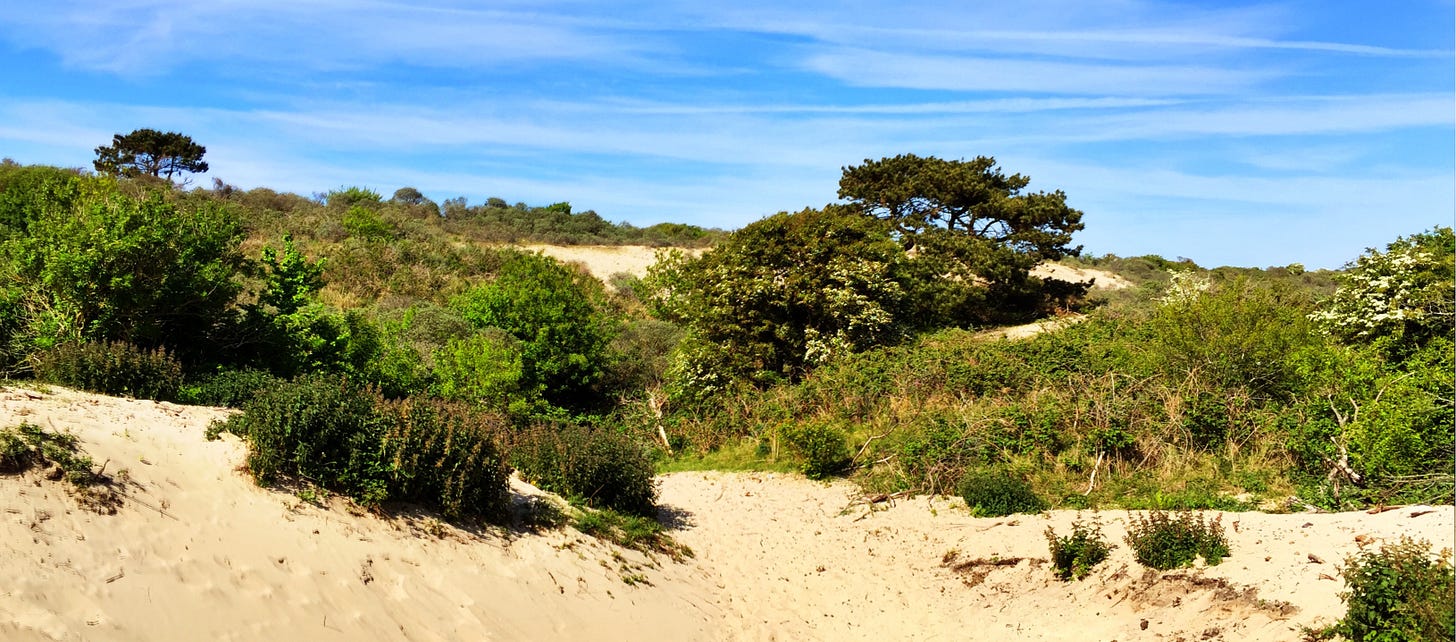The UN biodiversity summit likely delayed again
Island Stories #30: another existential crisis: the loss of biodiversity
While the destruction caused by the combination of the climate crisis and the loss of biodiversity creates headlines in the world’s newspapers, living on my island feels like being in the eye of the storm. But is it? I wrote recently that you can’t escape climate change and that the island of Schouwen-Duiveland is no exception. Gradual temperature rise has, for instance, changed the species of migrating birds that visit us. Still, it is primarily the increasing weather extremes that make it difficult for some species to cope with on this island.
The biodiversity is also at risk, and the Dutch nature conservation experts are constantly working to maintain the original variation of species as much as possible. I can see that in the dunes that are practically next door to where I live and in the forest that is a bit further from home, about a 45-minute walk, between the dunes and the beach.
Like last summer, conservationists remove the black cherry in the dunes and the forest. This shrub, or perhaps you may call it a small tree, is often referred to as the forest pest; an invasive species from America (Prunus Serotina). It overgrows the open sandy areas and the habitat of the native species. Removing the shrub creates wide-open spaces where the sand can drift again as it used to do in the past. In the sheltered places, unique plants are now growing, attracting many insects that in turn attract insect-eating birds.

Sheep are used to prevent new shrubs from the black cherry from developing. I often see them grazing in the dunes, where they are kept within a specific area for a few days and then moved on to the next patch to feed there for a few days.
Those sheep also play another role in promoting biodiversity; their fur transports seeds, spores, eggs, insects, snails, and spiders. Their excrement and anything that sticks between their hooves add to this spread. Seeds can remain germinable in the coat for months.
Now that climate change has finally made it to the front pages of the newspapers and the political agendas, one of the other existential threads is still out of the limelight: the loss of biodiversity. Last year, the COP15 summit of the UN Convention on Biological Diversity should have taken place in Kunming in China. But due to the COVID crisis, it was postponed to October this year. According to Reuters, it will now be delayed again until spring next year.
This all-important meeting on biodiversity loss can’t occur because of a pandemic, a disaster known to be increasingly likely in times of biodiversity loss. If our destruction of nature leads to habitat loss, it forces species to live together that usually wouldn’t meet, increasing the risk for pandemics. It’s a bit like postponing COP26 on climate action because of extreme weather in Glasgow.
The Kunming conference will now likely be split into two phases, with an event in mid-October that could be held at least partly online, followed by a second in-person session next year. Reuters adds: ‘With growing calls for the world to protect nature in tandem with tackling tackle climate change, countries are being urged at the conference to commit to put 30% of their land and sea territories under conservation by 2030. Currently, about 17% of land and 7% of seas fall under some sort of protection, but swathes of delicate ecosystems and species are under threat from overfishing, mining, or industrial pollution. Climate change impacts, including weather extremes and ocean acidification, are exacerbating the challenge’.
This newsletter could use your support:
Notes:
https://www.boswachtersblog.nl/aanzee/2021/05/21/schapen-in-de-duinen-2/








The fight agains invasive species is a difficult one but is being done in my area also. Goats are being used here to combat poison ivy and other plants but good to know that they can also distribute seeds of plants. Quail are used too to combat ticks. So much better to use these animals than pesticides which have contributed to insect loss.
Disturbing to learn so little of the land and seas are protected. That needs to change. It seems too often that developers have the upper hand and wetlands are lost. Loved the photo of the dunes.
I think this is my favorite sentence in this article: "It’s a bit like postponing COP26 on climate action because of extreme weather in Glasgow." Very well put!
It was very interesting to read about the sheep in the forest and how they help protect the dunes and also help in the fight against biodiversity loss. I bookmarked that boswachtersblog. And thank you for adding those pictures. They are beautiful and certainly help understand what is happing in those dunes.
I was surprised to read that only 17% of land and 7% of the seas are protected. Those numbers are incredibly low. Especially given the vastness of our oceans. 7% is almost no protection at all. Feels a bit like that total of 24% is about how much people care about a planet they are dependent on - that's pretty sad. Although if I think about it that way around, it also seems pretty accurate and that's even sadder.